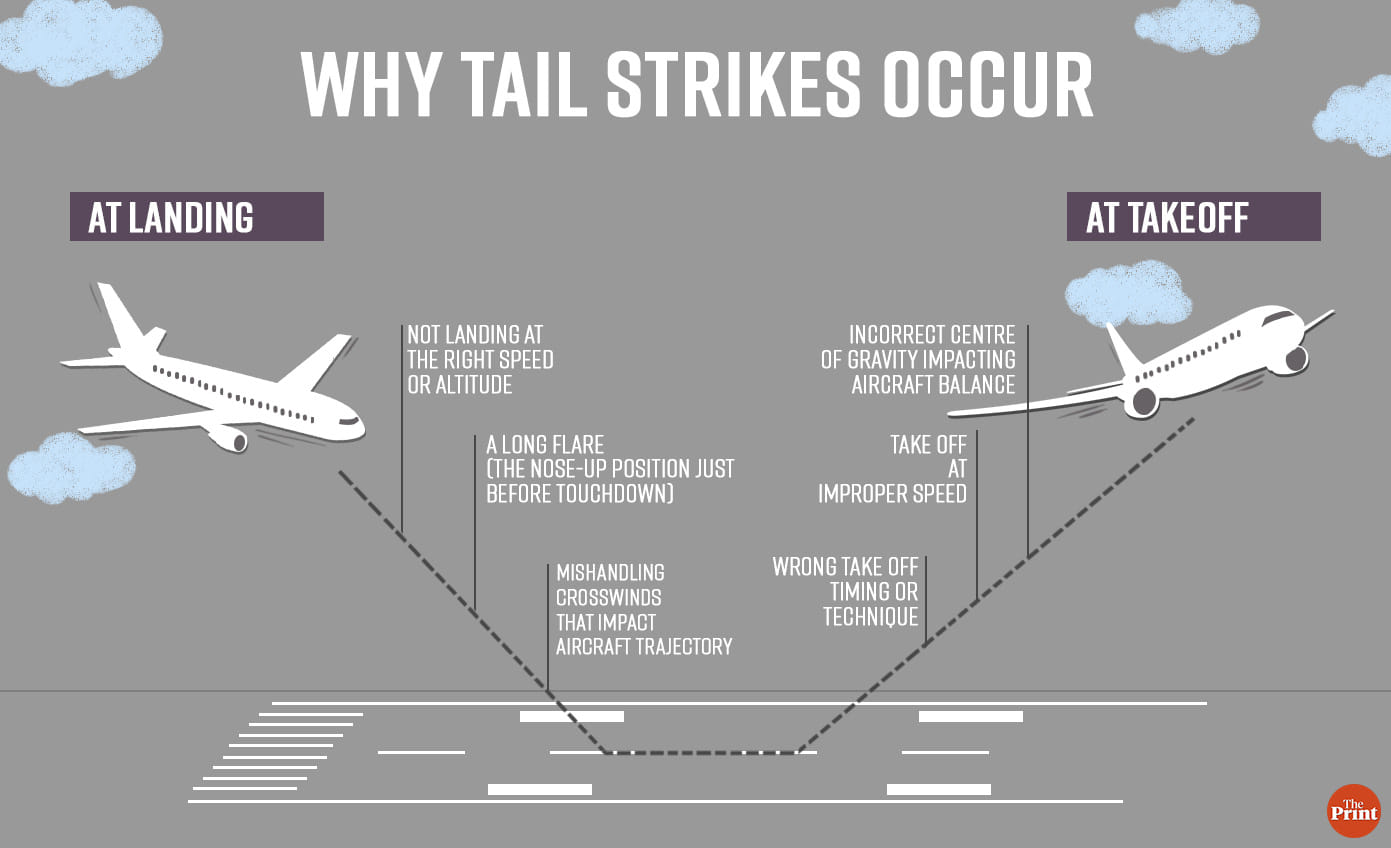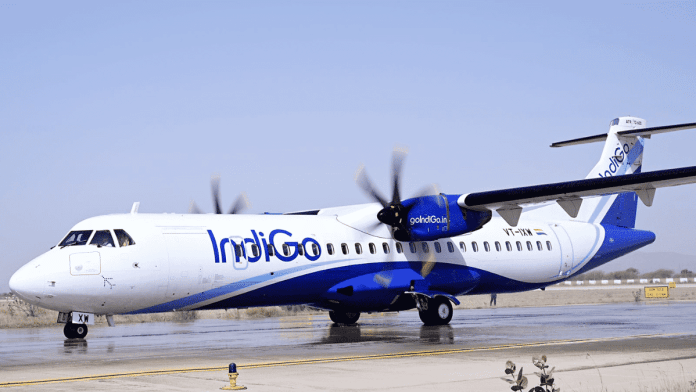New Delhi: Last week, the Indian aviation regulator Directorate General of Civil Aviation (DGCA) imposed a penalty of Rs 30 lakh on IndiGo, citing four tail strike incidents in the last six months. A ‘tail strike’ occurs when the rear part of the aircraft, the tail, comes in contact with the runway or any stationary object during takeoff or landing.
Following a special audit prompted by these incidents, the DGCA identified “certain systemic deficiencies” in the airline’s documentation pertaining to operations, training procedures, and engineering practices.
The DGCA then issued a show cause notice to IndiGo directing them to reply within the stipulated time period. However, the DGCA did not find the airline’s response satisfactory and imposed the penalty, while also directing IndiGo to amend their documents and procedures in line with DGCA’s requirements and Original Equipment Manufacturer (OEM) guidelines.
In response, IndiGo issued a statement noting that the audit “was presumably conducted in view of four tail strike incidents involving A321 aircraft in the past six months”. It also said that the airline had responded to the show cause notice on 19 July, 2023, indicating that there had been no violation of procedures laid down by the OEM and approved in the regulatory manuals.
“IndiGo has been given one month time to possibly appeal against the order. IndiGo is examining the DGCA order and shall respond to the DGCA order in due time,” the airline had said last week.
A major issue the DGCA reportedly found with IndiGo’s procedure was that it was asking pilots to land their planes using a ‘Flap 3’ landing. This landing technique involves using only three of the four available flaps, which helps reduce drag, requires less thrust, and leads to lower fuel consumption during the plane’s approach to the runway.
According to a 28 July report in The Hindu, pilots have been told that 6 kg of fuel could be saved with every landing using this technique. The article adds that such landings could be trickier at airports situated at an elevation, such as Mumbai, Delhi, and Bengaluru.
Here’s a look at why tail strikes occur and why they are an issue.
Also Read: India’s aviation industry has no cycles of boom or bust. It’s constant headwinds, tailwinds
What makes an aircraft prone to tail strikes?
Tail strikes can occur in all models and types of planes, but certain aircraft designs, particularly those with a longer fuselage (main body) are more susceptible to the issue.
The A321 model of Airbus — which was involved in IndiGo’s tail strike incidents — features a “stretched fuselage”, measuring 146 feet in length. Aircraft manufacturer Airbus identifies it as “the longest-fuselage member” of its A320 family, of which the IndiGo aircraft is a part.
According to experts, tail strikes have become more common as manufacturers increasingly make aircraft with longer fuselages. Totably, many aircraft also come with a tail skid—a small attachment that helps protect damage from tail strikes by absorbing the impact.
When do they happen?

Tail strikes can occur in both daylight and darkness as well as in good or bad weather, but the most significant contributing factor is the flight crew’s experience with the specific aircraft model, according to an article in AERO, a quarterly magazine published between 1998 and 2014 by American aircraft maker Boeing.
“While tail strike may occur to pilots with abundant flight time in a model, most occur to pilots who are transitioning from one airplane model to another and have fewer than 100 hours of flight time in the new model,” said an AERO article titled ‘Tail Strike Avoidance’, published on 4 October, 1998.
“Incidents are greatest among pilots during their first heavy-weight operations in the new model, especially when the weather is marginal,” it added.
According to data from European aircraft maker Airbus, about 65 percent of tail strikes occur during landings, while the rest are during takeoff.
What causes tail strikes during landing?
The most common factor contributing to almost every tail strike during landing is an unstable approach—when the aircraft does not come in to land at the right speed or altitude. This is the biggest single cause of tail strikes.
For example, according to an Airbus document, too high a flare — the nose-up movement of a landing airplane just prior to touchdown, which helps slow the descent and allows the airplane to land smoothly — can result in decreased airspeed, which can result in a tail strike on landing.
The second most common cause of a landing tail strike is a long flare. That is, the airplane is held in a nose-up position for too long, decreasing its speed.
When the aircraft is close to the ground, the wind velocity tends to decrease, and the wind direction tends to turn, explains the Airbus document. The flight crew must be aware that during the approach phase, and especially during the flare, a crosswind effect could suddenly increase the pitch of the aircraft, and result in a tail strike.
Also Read: Restrain them, DGCA advises airlines on unruly passengers, categorises offence for apt punishment
Tail strikes causes during takeoff
During take-off, tail strikes can be caused by factors such as mistrimmed stabilisers, rotation at improper speed, and excessive rotation rates.
A stabiliser is an important component of a plane, the length of which is key to determining the craft’s centre of gravity, which in turn is critical to safe takeoffs and landings. According to the Boeing article, a mistrimmed stabiliser throws off the centre of gravity of the aircraft, impedes the pilot’s ability to balance it properly, and thus can increase the chances of a tail strike.
For context, “trimming” an aircraft refers to adjusting the aerodynamic forces on the control surfaces, such as a rudder, elevator, or aileron. This allows the aircraft to maintain the set attitude without any control input.
An aircraft stabliser is adjusted to ensure that the plane’s centre of gravity — the point at which its weight is evenly balanced— falls within the specifications mentioned by the aircraft manufacturer. Since this is done to ensure the aircraft’s stability, any error can lead to a tail strike.
Another significant reason for tail strikes during take-offs, according to the same AERO article, is when the plane hasn’t reached the required speed, which varies depending on the weight of the fuel, passengers, and cargo. If the pilot pulls back on the control stick to lift the nose wheel before attaining the required speed, there is a risk of a tail strike.
In addition, rotation — the act of pulling back on the control stick to lift the nose wheel during takeoff — must be executed in a balanced and measured manner. When rotation is done too rapidly, known as an excessive rotation rate, it can result in a tail strike.
“Flight crews operating an airplane model that is new to them, especially when transitioning from unpowered flight controls to ones with hydraulic assistance, are most vulnerable to using excessive rotation rate,” the AERO article says.
While additional factors may play a role, these, according to the article, are the most significant reasons for tail strikes.
“Most importantly, the examination showed that each is under the direct control of the flight crew, and therefore can be avoided with proper understanding and training,” the article noted.
Are tail strikes dangerous?
While there is typically a low fatality risk due to tail strikes, these occurrences can cause serious damage to aircraft and cost operators millions in repairs and lost revenue.
They can also cause significant damage to the pressure bulkhead, failure of which “during flight can cause a catastrophic event if the flight continues while pressurised”, according to another AERO article published in the first quarter of 2007.
A pressure bulkhead is a structure that closes off the rear end of the aircraft. It helps the aircraft maintain pressure while cruising at an altitude and protects it from damage or bursting due to high internal pressure.
Tail strikes are expensive, too. During a safety investigation, one airline reported that a single tail strike cost its company $12 million in repair costs and loss of revenue during the repair, the article says.
According to global aviation body International Air Transport Association (IATA), when a tail strike occurs during landing, the damage is typically more severe than when it occurs during takeoff.
“The worst-case scenario involves the tail striking the runway before the landing gear touches down, damaging the aircraft pressure bulkhead,” it said in its annual safety report last year.
It further said: “Tail strikes can be avoided if flight crew are aware of their contributing factors and adhere to the established standard procedures, that should be reinforced by training programs on proper takeoff and landing procedures”.
(Edited by Uttara Ramaswamy)
Also Read: IndiGo, Air India soar at Paris Air Show. But Indian aviation must stay grounded by reality






